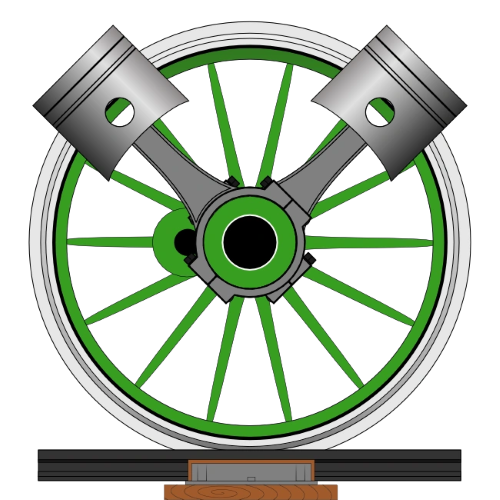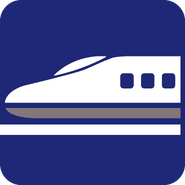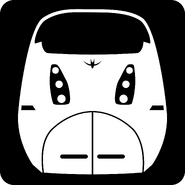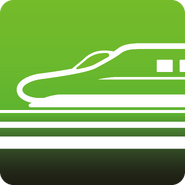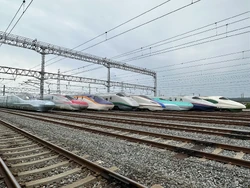
A lineup of JR East Shinkansen sets in May 2023
The Shinkansen is a high-speed rail network in Japan. Initially built to connect distant regions within Japan with Tokyo, the capital, the Shinkansen network has since expanded to 2,830.6 km (1,758.9 mi) of main lines with maximum speeds of 210 – 320 km/h (130 – 199 mph), 283.5 km (176.2 mi) of mini-Shinkansen track with a maximum speed of 130 km/h (81 mph) and 10.3 km (6.4 mi) of spur lines. The network is owned by the Japan Railway Construction, Transport and Technology Agency, covers most major cities on the islands of Honshu and Kyushu and Hakodate in Hokkaido and is operated by five branches of the Japan Railways Group. The network was initially operated by the Japanese National Railways, the predecessor company of what is now the Japan Railways Group.
Etymology[]
"Shinkansen" literally translates to "new branch line" or "new trunk line"; this word is currently used to refer to both the lines and the trains themselves. In English, the trains are often colloquially referred to as bullet trains due to their resemblance to a bullet and their high speeds; the term "bullet train" actually predates the Shinkansen network, being a literal translation of the Japanese term dangan ressha, referring to early high-speed rail projects undertaken by the JNR from around 1939. Officially, the service is referred to as "Superexpress" in announcements although the Shinkansen name is used on signage in stations.
History[]
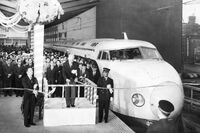
Opening ceremony of the Tōkaidō Shinkansen on 1 October 1964
Prior to the opening of the Shinkansen, Japan had dabbled in the construction of what was known as the dangan ressha project around 1939, designing steam locomotives which would supposedly be capable of high speeds as part of what would be known as the Greater East Asian Railroad. The onset of World War II meant that these plans would ultimately not come to fruition, although some segments of the planned railway network would ultimately be built. These lines would use 1,435 mm (4 ft 8 1⁄2 in) track to allow for higher speeds than what was possible on narrow gauge track mostly used throughout Japan.
Two individuals who the development of the Shinkansen can be attributed to are Hideo Shima and Shinji Sogō. Shima was JNR's chief engineer and the director of the rolling stock department in the past, while Sogō was the JNR's president; both convinced politicians to back the plan. Other significant people responsible were three engineers at the Railway Technology Research Institute, the JNR's research and development department; these engineers were Tadanao Miki, Tadashi Matsudaira and Hajime Kawanabe. All three were pivotal in the development of the first line, the Tōkaidō Shinkansen, and had worked on aircraft designs during World War II; Miki is credited for the design of the original Shinkansen sets.
After World War II, high-speed rail was largely pushed to the wayside while passenger and freight traffic on the Tōkaidō Main Line steadily increased; by the mid-1950s the line was at capacity and the project was revisited. In 1957, the Odakyu Electric Railway introduced their 3000 series Romancecar model, setting a world speed record of 145 km/h (90 mph) for a narrow gauge train; seeing this, Shima was struck with inspiration and became convinced that a standard gauge train with the capability of being even faster than what was recently observed was possible. Despite the Japanese national attitude at the time believing that railways would soon be obsoleted by air travel and highways as in other countries such as the United States and Europe, Sogō insisted strongly on the prospects of high-speed rail and thus the project commenced.
Government approval for the project came in 1958, with construction of the first segment of the first line, the Tōkaidõ Shinkansen, commenced in April 1959 between Tokyo and Osaka. The cost for construction was initially estimated at ¥200b, raised in the form of government loans, railway bonds and a low-interest loan of US$80m from the World Bank; this estimate would later prove to be deliberately understated, with actual construction costs coming to around ¥400b instead. With budget shortfalls becoming clear, Sogō resigned from his position in 1963, taking responsibility for his actions; he was replaced by Reisuke Ishida.
By 1962, a 32 km (20 mi) section of track known as the "Kamonomiya model track" was constructed between Ayase and Odawara and test rolling stock manufactured for testing on the section of track. The Tōkaidō Shinkansen was completed in 1964 and began service on 1 October 1964, with 12-car Shinkansen set H2 pulling the first Hikari service bound for Shin-Osaka at 6:00 am JST. In service in time for the 1964 Tokyo Olympics, the service cut down the time of trip between both major cities from about 6 hours and 40 minutes to about 4 hours; this was cut down further to about 3 hours and 10 minutes by the next year. An immediate success, the 100 millionth passenger mark was reached by the service on 13 July 1967 and the 1 billionth passenger rode on the service in 1976.
The resounding success of the Tōkaidō Shinkansen prompted a westward expansion of the line, now known as the San'yō Shinkansen; it connected Okayama, Hiroshima and Fukuoka and was completed in 1975. Prime minister Kakuei Tanaka was one of the Shinkansen's most ardent supporters, his government proposing an extensive network of Shinkansen lines paralleling most major main lines; two lines, the Tōhoku and Jōetsu Shinkansen, both opened in 1982, would be built as part of this plan. However, many of these planned lines, such as the Narita Shinkansen, would end up being delayed or canceled entirely due to their costs; the high costs caused the JNR to incur significant debts. By the 1980s, the JNR was practically insolvent, with a decision being made to privatize the company; the JNR was privatized on 1 April 1987, splitting into seven successor companies, of which three would inherit the Shinkansen network.
Today, the Shinkansen network consists of eight main lines operated by five companies, two mini-Shinkansen lines and two spur lines; one line is under construction and two lines have extensions under construction. Additional phases for three lines are in the planning stage.
Network[]
The Shinkansen network currently consists of eight main lines operated by five of JR's divisions; JR Central operates the Tōkaidō Shinkansen, JR East the Tōhoku and Jōetsu Shinkansen, JR West the San'yō Shinkansen, JR Kyushu the Kyushu and Nishi Kyushu Shinkansen and JR Hokkaido the Hokkaido Shinkansen; JR East and West jointly operate the Hokuriku Shinkansen (initially known as the Nagano Shinkansen until circa 2015). Two further lines, the Yamagata and Akita Shinkansen, are mini-Shinkansen lines, created by upgrading and regauging existing sections of track; both are operated by JR East. Two spur lines also exist, using Shinkansen rolling stock but are not operated at high speeds; these are JR West's Hakata-Minami Line and JR East's Gala-Yuzawa Line, the latter of which is a seasonal line only operating during the winter ski season. These lines use Shinkansen rolling stock as they feature tracks running towards maintenance depots or yards.
Initially intended to carry both passenger and freight trains, Shinkansen trains only carry passengers. Between midnight and 6:00 am every day, the network shuts down for maintenance; during this time, experimental non-revenue trains may also be found running. Three types of services exist: express services, the fastest services only stopping at major stations, semi-express services which stop at all major stations as well as some smaller stops and the local services which stop at all stops. Each service is given a name and number (e.g. Toki 307); on some occasions a name from a previous JNR limited express service is reused for a Shinkansen service. All Shinkansen services are covered under the Japan Rail Pass (a type of discount ticket for large-scale rail travel) with the exception of the Nozomi and Mizuho services, where a special ticket is required to ride on these services on top of the fee for the rail pass.
Shinkansen rails never intersect with slower, older conventional lines, with the exception of mini-Shinkansen lines which run along these older lines; there are also no freight trains running along these lines and are grade separated from roads and highways (i.e. no grade crossings), with tunnels and viaducts used to go over or through obstacles, allowing Shinkansen trains to run punctually. Continuous welded rails and swingnose crossing points are used on the network to eliminate gaps between turnouts and crossings; long rails are used, joined by expansion joints to minimize any gauge fluctuation due to thermal elongation or shrinkage. Ballasted and slab track is used on the network, with the slab tracks using rails and fasteners with a cement asphalt mortar and employed on sections with concrete beds like viaducts and tunnels. The entire signal system for the Shinkansen is computerized, using an automatic train control system; centralized traffic control manages all operations. To overcome the limitations of DC current on most lines, the Shinkansen network uses a 25 kV AC power system.
All Shinkansen trains are electric multiple units ranging from seven to sixteen cars long; the longest trains are around 400 m (0.25 mi) long, with platforms made similarly long to allow for train lengths. Shinkansen sets are also built to a larger loading gauge than other Japanese rolling stock and feature faster acceleration and braking when compared to other types of Japanese rolling stock.
Service names[]
The translation of the service name (if available), type of service and operators are in brackets.
- Tōkaidō, San'yō and Kyushu Shinkansen
- Nozomi ("hope", express, Central/West)
- Hikari/Hikari Rail Star ("light", semi-express, Central/West)
- Kodama ("echo", local, Central/West)
- Mizuho ("harvest", express, West/Kyushu)
- Sakura ("cherry blossom", semi-express, West/Kyushu)
- Tsubame ("swallow", local, Kyushu)
- Tōhoku, Hokkaido, Yamagata and Akita Shinkansen
- Hayabusa ("peregrine falcon", express, East/Hokkaido)
- Hayate ("gale", local, East/Hokkaido)
- Yamabiko ("mountainous echo", semi-express, East)
- Nasuno (local, East)
- Aoba (semi-express, East, discontinued)
- Komachi ("beauty", Mini, East)
- Tsubasa ("wing", Mini, East)
- Jōetsu Shinkansen
- Toki ("crane", semi-express, East)
- Tanigawa (local, East)
- Asahi ("morning sun", semi-express, East, discontinued)
- Hokuriku Shinkansen
- Kagayaki ("radiance", express, East/West)
- Hakutaka ("white hawk", semi-express, East/West)
- Tsurugi ("sword", local, East/West)
- Asama (local, East/West)
- Nishi Kyushu Shinkansen
- Kamome ("seagull", local, Kyushu)
Rolling stock[]
Current[]
| Image | Name | Manufacturer(s) | Operators | Build date | Entered service | Fleet numbers | Train length | Services used | Top speed |
|---|---|---|---|---|---|---|---|---|---|

|
500 Series Shinkansen | Hitachi, Kawasaki Heavy Industries, Kinki Sharyo, Nippon Sharyo | JR West | 1995 – 1998 | 22 March 1997 | W1, V2 – V9 | 8 cars per set Past: 16 cars per set |
Kodama Past: Hikari, Nozomi |
300 km/h (186 mph) By design: 320 km/h (199 mph) |

|
700 Series Shinkansen | Hitachi, Kawasaki Heavy Industries, Kinki Sharyo, Nippon Sharyo | JR West Past: JR Central |
1997 – 2006 | 13 March 1999 | E1 – E16 | 8 cars per set Past: 16 cars per set |
Hikari Rail Star, Kodama Past: Hikari, Nozomi |
285 km/h (177 mph) |

|
N700 Series Shinkansen | Hitachi, Kawasaki Heavy Industries, Kinki Sharyo, Nippon Sharyo | JR Central, JR West, JR Kyushu | 2005 – 2020 | 1 July 2007 | JR Central: X0 – X80, G1 – G25 JR West: F1 – F24, K1 – K16 JR Kyushu: S1 – S19, R1 – R11 |
JR Central/West: 16 cars per set JR Kyushu: 8 cars per set |
JR Central/West: Nozomi, Hikari, Kodama JR Kyushu: Mizuho, Sakura, Tsubame |
300 km/h (186 mph) Speed record: 332 km/h (206 mph) |

|
N700S Series Shinkansen | Hitachi, Nippon Sharyo | JR Central, JR West, JR Kyushu | 2018, 2020 – Present | 1 July 2020 | JR Central: J0 – J59 JR West: H1 – H4 JR Kyushu: Y1 – Y4 |
JR Central/West: 16 cars per set JR Kyushu: 6 cars per set |
JR Central/West: Nozomi JR Kyushu: Kamome |
300 km/h (186 mph) Speed record: 363 km/h (226 mph) |

|
800 Series Shinkansen | Hitachi | JR Kyushu | 2003 – 2010 | 12 March 2004 | U001 – U009 | 6 cars per set | Sakura, Tsubame | 260 km/h (162 mph) By design: 285 km/h (177 mph) |

|
E2 Series Shinkansen | Hitachi, Kawasaki Heavy Industries, Nippon Sharyo, Tokyu Car Corporation | JR East | 1995 – 2010 | 22 March 1997 | N1 – N13, N21, J2 – J15, J51 – J75 | 10 cars per set Past: 8 cars per set |
Yamabiko, Nasuno Past: Asahi, Toki, Asama, Hayate, Tanigawa |
275 km/h (171 mph) Speed record: 362 km/h (225 mph) |

|
E3 Series Shinkansen | Kawasaki Heavy Industries, Tokyu Car Corporation | JR East | 1995 – 2009 | 22 March 1997 | R1 – R26, L51 – L55, L61 – L72 | 7 cars per set Past: 5 or 6 cars per set |
Tsubasa Past: Komachi, Toreiyu Tsubasa, Genbi Shinkansen |
275 km/h (171 mph) |

|
E5 Series Shinkansen | Hitachi, Kawasaki Heavy Industries | JR East | 2009 – Present | 5 March 2011 | U1 – U59 | 10 cars per set | Hayabusa, Hayate, Yamabiko, Nasuno | 320 km/h (199 mph) |

|
E6 Series Shinkansen | Hitachi, Kawasaki Heavy Industries | JR East | 2010 – 2014 | 16 March 2013 | Z1 – Z24 | 7 cars per set | Komachi | 320 km/h (199 mph) |

|
E7 Series Shinkansen | Hitachi, J-TREC, Kawasaki Heavy Industries | JR East | 2013 – Present | 15 March 2014 | F1 – F47 | 12 cars per set | Kagayaki, Hakutaka, Tsurugi, Asama, Toki, Tanigawa | 275 km/h (171 mph) |

|
E8 Series Shinkansen | Hitachi, J-TREC, Kawasaki Railcar Manufacturing | JR East | 2022 – Present | 16 March 2024 | G1 – G15 | 7 cars per set | Tsubasa | 300 km/h (186 mph) |

|
H5 Series Shinkansen | Hitachi, Kawasaki Heavy Industries | JR Hokkaido | 2014 – 2015 | 26 March 2016 | H1 – H4 | 10 cars per set | Hayabusa, Hayate, Yamabiko, Nasuno | 320 km/h (199 mph) |

|
W7 Series Shinkansen | Hitachi, Kawasaki Heavy Industries, Kinki Sharyo | JR West | 2014 – Present | 14 March 2015 | W1 – W14, W17 – W22, W24 | 12 cars per set | Kagayaki, Hakutaka, Tsurugi, Asama | 275 km/h (171 mph) |
Withdrawn[]
| Image | Name | Manufacturer(s) | Operators | Build date | Entered service | Withdrawn from service | Fleet numbers | Train length | Services used | Top speed |
|---|---|---|---|---|---|---|---|---|---|---|

|
0 Series Shinkansen | Hitachi, Kawasaki Sharyō, Kinki Sharyo, Kisha Seizō, Nippon Sharyo, Tokyu Car Corporation | JNR, JR Central, JR West | 1964 – 1986 | 1 October 1964 | 14 December 2008 | Various | 4, 6, 8, 12 or 16 cars per set | Hikari, Kodama | 220 km/h (137 mph) |

|
100 Series Shinkansen | Hitachi, Kawasaki Heavy Industries, Kinki Sharyo, Nippon Sharyo, Tokyu Car Corporation | JNR, JR Central, JR West | 1984 – 1991 | 1 October 1985 | 16 March 2012 | X1 – X7, G1 – G50, V1 – V9, K51 – K60, P1 – P12 | 4, 6, 8, 12 or 16 cars per set | Hikari, Kodama | 230 km/h (143 mph) |

|
200 Series Shinkansen | Hitachi, Kawasaki Heavy Industries, Kinki Sharyo, Nippon Sharyo, Tokyu Car Corporation | JNR, JR East | 1980 – 1991 | 23 June 1982 | 14 April 2013 | Various | 8, 10, 12, 13 or 16 cars per set | Asahi, Aoba, Toki, Yamabiko, Asama, Nasuno, Tanigawa | 240 km/h (143 mph) Some sets: 275 km/h (171 mph) |

|
300 Series Shinkansen | Hitachi, Kawasaki Heavy Industries, Kinki Sharyo, Nippon Sharyo | JR Central, JR West | 1990 – 1998 | 14 March 1992 | 16 March 2012 | J1 – J61, F1 – F9 | 16 cars per set | Nozomi, Hikari, Kodama | 270 km/h (168 mph) Speed record: 325.7 km/h (202.4 mph) |

|
400 Series Shinkansen | Hitachi, Kawasaki Heavy Industries, Tokyu Car Corporation | JR East | 1992 – 1995 | 1 July 1992 | 18 April 2010 | L1 – L12 | 7 cars per set Past: 6 cars per set |
Tsubasa | 240 km/h (143 mph) Speed record: 345 km/h (214 mph) |

|
E1 Series Shinkansen | Hitachi, Kawasaki Heavy Industries | JR East | 1994 – 1995 | 15 July 1994 | 28 October 2012 | M1 – M6 | 12 cars per set | Asahi, Toki, Yamabiko, Aoba, Nasuno, Tanigawa | 240 km/h (143 mph) |

|
E4 Series Shinkansen | Hitachi, Kawasaki Heavy Industries | JR East | 1997 – 2003 | 20 December 1997 | 17 October 2021 | P1 – P22, P51 – P52, P81 – P82 | 8 cars per set | Asahi, Toki, Yamabiko, Nasuno, Tanigawa | 240 km/h (143 mph) |
Future[]
| Image | Name | Manufacturer(s) | Operators | Build date | Entering service | Fleet numbers | Train length | Services used | Top speed |
|---|---|---|---|---|---|---|---|---|---|

|
L0 Series Shinkansen | Hitachi, Mitsubishi Heavy Industries, Nippon Sharyo | JR Central | 2011 – 2012, 2020 | Unknown | Unknown | 16 cars per set | Unknown | 505 km/h (314 mph) Speed record: 603 km/h (375 mph) |
Non-revenue[]
| Image | Name | Manufacturer(s) | Operators | Build date | Entered service | Withdrawn from service | Fleet numbers | Train length | Official name | Top speed/speed record(s), if any |
|---|---|---|---|---|---|---|---|---|---|---|

|
Class 1000 Shinkansen | Hitachi, Kawasaki Sharyō, Kinki Sharyo, Kisha Seizō, Nippon Sharyo | JNR | 1961 – 1962 | 26 June 1962 | 15 August 1975 | A – B | 2 or 4 cars per set | None | 256 km/h (159 mph) |

|
Class 951 Shinkansen | Kawasaki Sharyō, Nippon Sharyo | JNR | 1969 | 2 July 1969 | 11 April 1990 | None | 2 cars per set | None | 286 km/h (178 mph) |

|
Class 961 Shinkansen | Hitachi, Kawasaki Heavy Industries, Nippon Sharyo | JNR | 1973 | 17 July 1973 | 10 August 1990 | S3 | 6 cars per set | None | 319 km/h (198 mph) |

|
Class 962 Shinkansen | Hitachi, Kawasaki Heavy Industries, Nippon Sharyo | JNR | 1979 | 22 February 1979 | January 1983 | None | 6 cars per set | None | 210 km/h (130 mph) |

|
Class 922 Shinkansen | Hitachi, Kawasaki Sharyō, Kinki Sharyo, Tokyu Car Corporation | JNR, JR Central, JR West | 1964, 1974, 1979 | July 1964 | September 2005 | T1 – T3 | 4 or 7 cars per set | Doctor Yellow | T1: 200 km/h (124 mph) T2/T3: 210 km/h (130 mph) |

|
Class 923 Shinkansen | Hitachi, Nippon Sharyo | JR Central, JR West | 2000, 2005 | October 2000 | Active | T4 – T5 | 7 cars per set | Doctor Yellow | 270 km/h (168 mph) |

|
Class 925 Shinkansen | Hitachi, Kawasaki Heavy Industries, Kinki Sharyo, Nippon Sharyo, Tokyu Car Corporation | JNR, JR East | 1979 | November 1979 | 25 September 2002 | S1 – S2 | 7 cars per set | Doctor Yellow | 275 km/h (171 mph) |

|
Class 941 Shinkansen | Kisha Seizō, Nippon Sharyo | JNR | 1961 | Never used | N/A | None | 2 cars per set | "Emergency relief train" | N/A |

|
E926 Series Shinkansen | Tokyu Car Corporation | JR East | 2001 | 2001 | Active | S51 | 6 cars per set | East i | 275 km/h (171 mph) |

|
500-900 Series Shinkansen | Hitachi, Kawasaki Heavy Industries | JR West | 1992 | 8 June 1992 | 25 May 1996 | W0 | 6 cars per set | WIN350 | 350.4 km/h (217.7 mph) |

|
Class 952/953 Shinkansen | Hitachi, Kawasaki Heavy Industries, Nippon Sharyo | JR East | 1992 | 27 March 1992 | 17 February 1998 | S5 | 9 cars per set | STAR21 | 425 km/h (264 mph) |

|
Class 955 Shinkansen | Hitachi, Kawasaki Heavy Industries, Mitsubishi Heavy Industries, Nippon Sharyo | JR Central | 1994 | 25 May 1995 | 1 February 2002 | A0 | 6 cars per set | 300X | 443 km/h (275 mph) |

|
Class E954 Shinkansen | Hitachi, Kawasaki Heavy Industries | JR East | 2005 | 25 June 2005 | 7 September 2009 | S9 | 8 cars per set | Fastech 360S | 360 km/h (224 mph) By design: 405 km/h (252 mph) |

|
Class E955 Shinkansen | Hitachi, Kawasaki Heavy Industries | JR East | 2006 | March 2006 | October 2008 | S10 | 6 cars per set | Fastech 360Z | By design: 405 km/h (252 mph) |

|
Class E956 Shinkansen | Hitachi, Kawasaki Heavy Industries | JR East | 2018 – 2019 | 9 May 2019 | Active | S13 | 10 cars per set | ALFA-X | 382 km/h (237 mph) By design: 405 km/h (252 mph) |
Gallery[]
References[]
- Book: The Complete Book of Locomotives By Colin Garratt, published by Herms House. ISBN: 978-1-84477-022-9.
| Shinkansen | ||||||||||||||||||||||||
|---|---|---|---|---|---|---|---|---|---|---|---|---|---|---|---|---|---|---|---|---|---|---|---|---|
| Active | JR West | 500 • 700 • N700 • N700S • W7 | ||||||||||||||||||||||
| JR East | E2 • E3 • E5 • E6 • E7 • E8 | |||||||||||||||||||||||
| JR Central | N700 • N700S | |||||||||||||||||||||||
| JR Kyushu | N700 • N700S • 800 | |||||||||||||||||||||||
| JR Hokkaido | H5 | |||||||||||||||||||||||
| Withdrawn | JR West | 0 • 100 • 300 | ||||||||||||||||||||||
| JR East | 200 • 400 • E1 • E4 | |||||||||||||||||||||||
| JR Central | 0 • 100 • 300 • 700 | |||||||||||||||||||||||
| Future | JR Central | L0 | ||||||||||||||||||||||
| Non-revenue | JNR | 922 • 925 • 941 • 951 • 961 • 962 • 1000 | ||||||||||||||||||||||
| JR West | 922 • 923 • 500-900 | |||||||||||||||||||||||
| JR East | 925 • 952/953 • E926 • E954 • E955 • E956 | |||||||||||||||||||||||
| JR Central | 922 • 923 • 955 | |||||||||||||||||||||||
| RTRI | FGT-9000 • GCT01 • GCT01-200 • ML100 • ML500 • ML500R • MLU001 • MLU002 • MLU002N • MLX01 | |||||||||||||||||||||||
| Other | JR Central | Super Hikari Model | ||||||||||||||||||||||
